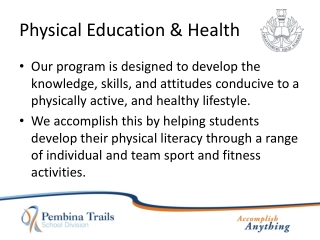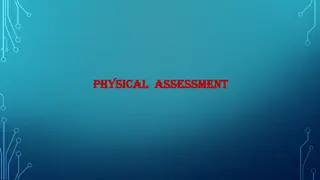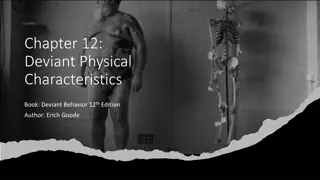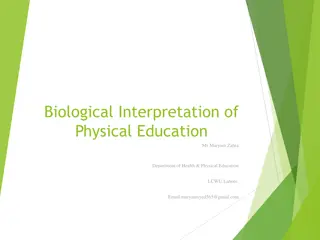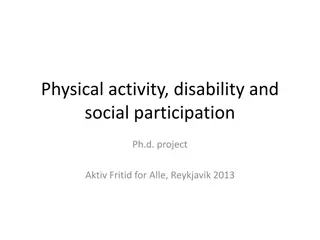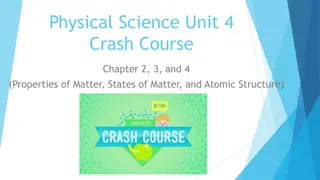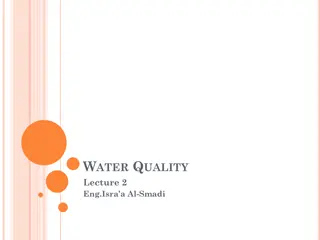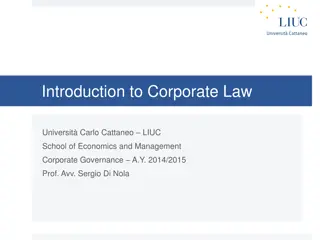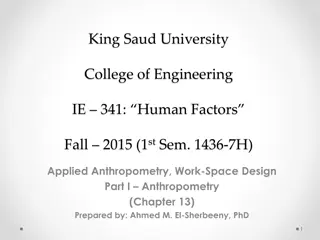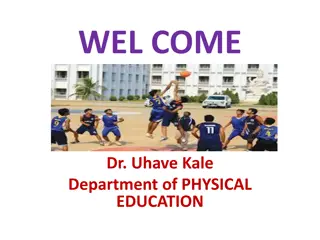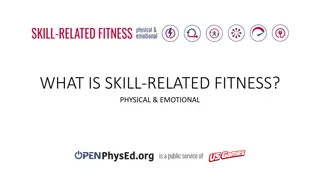Physical Education & Health
Our Physical Education and Health program focuses on developing physical literacy, mental health awareness, and responsible behaviors for students to lead a healthy lifestyle. With a holistic approach, we offer a wide range of activities, integrated health topics, and access to facilities like the A
1 views • 9 slides
Understanding Childhood Obesity: Physical and Emotional Impact
Explore the physical and emotional ramifications of childhood obesity, addressing key culprits like poor nutrition and lack of physical activity. Discover strategies to decrease childhood obesity, improve wellness, and enhance academics by integrating physical and nutrition education. Gain insights
6 views • 33 slides
Physical Distribution
Physical distribution is a critical aspect of business operations involving the planning, implementation, and control of the flow of goods from origin to consumer. Philip Kotler and William J. Stanton have defined physical distribution as a process of managing the movement of goods to meet consumer
0 views • 8 slides
Exploring the Meaning and Definitions of Physical Education
Physical education involves systematic training and instruction related to physical activities for the development and maintenance of the human body. It encompasses the growth of physical power, the cultivation of physical skills, and overall enhancement of physical well-being. Various definitions h
9 views • 7 slides
Importance of Fitness Testing in Physical Education
Health-related physical activity (HRPA) stresses the need to view fitness testing as a tool to promote increased physical activity levels rather than an end goal. The focus in school physical education is on equipping youth with the knowledge and skills for lifelong health. Fitness test protocols sh
0 views • 17 slides
Impact of North America's Physical Characteristics on Settlement Patterns
Physical characteristics such as landforms, bodies of water, climate, and natural resources in North America play a significant role in shaping settlement patterns. Major features like the Mississippi River System, Appalachian Mountains, Rocky Mountains, and Canadian Shield have influenced how and w
5 views • 13 slides
Predicting Doctor of Physical Therapy First-Time Pass Rates on the National Physical Therapy Examination
This study by Latoya Green investigates the relationship between cognitive variables such as professional graduate GPA, PEAT, HSRT, and NPTE to predict first-time pass rates on the National Physical Therapy Examination. The Health Sciences Reasoning Test (HSRT) measures critical thinking in a health
2 views • 8 slides
Understanding Physical Examination: Importance and Purpose
Physical examination plays a crucial role in assessing a patient's physical and mental well-being, detecting diseases early, and establishing a good doctor-patient relationship. It involves systematically collecting objective information through examination techniques. The examination helps identify
2 views • 34 slides
Understanding Pharmaceutical Degradation: Types and Factors
Pharmaceutical degradation refers to the process of a formulation in a specific container losing its chemical, microbiological, therapeutic, physical, and toxicological specifications. It can be categorized into physical, chemical, and microbiological degradation. Physical degradation alters the dru
1 views • 50 slides
Physical Geography of Pakistan: Mountains, Plains, Plateaus, and Deserts
Pakistan's diverse physical features include towering mountains like the Karakoram and Himalayas, expansive plains, elevated plateaus, and vast deserts. The country shares borders with China, India, Iran, Afghanistan, and the Arabian Sea. The Northern Mountains consist of distinct ranges like the Ka
1 views • 29 slides
Exploring Deviant Physical Characteristics in Society
Delve into the societal impact of deviant physical characteristics as discussed in Erich Goode's book "Deviant Behavior 12th Edition." Unveil the diverse reactions individuals face, from resistance to internalization, due to stigmatization based on appearance. Explore topics like physical disability
2 views • 14 slides
Understanding Reach Characteristics in HEC-HMS Basin Modeling
Reach characteristics play a crucial role in hydrological modeling using HEC-HMS. Georeferenced reaches are essential for computing reach characteristics like slope, sinuosity, relief, and more. The process involves pre-processing drainage data before detailed reach characteristics can be obtained.
0 views • 5 slides
Understanding Regions in Geography
Regions in geography are defined by common features such as climate, landscape, language, or religion. They serve as basic units of geography, with the Middle East being a notable example encompassing political, environmental, and religious characteristics. Regions can be classified based on physica
0 views • 10 slides
Understanding the Differences and Characteristics of BJT and FET in Electronics
Learn about the disparities between Bipolar Junction Transistors (BJT) and Field-Effect Transistors (FET) in this informative content. Explore the construction, operation, and characteristics of these semiconductor devices, including N-channel JFET specifics, operating behaviors such as pinch-off, d
2 views • 9 slides
Supporting Healthy Aging Through Physical Activity: Workshop Highlights
Explore the insights from an online workshop focusing on supporting healthy aging through physical activity for older adults. The workshop covers topics such as increasing awareness of the importance of physical activity, incorporating activities into daily routines, setting goals, and sustaining pr
0 views • 23 slides
Promoting Physical Activity in Island Communities: The Urgent Need for Change
Island communities are facing a crisis of physical inactivity among children, leading to increasing rates of obesity and related health issues. Lack of promotion of physical activity in schools and workplaces is contributing to this problem. Urgent action is required to prioritize daily exercise and
0 views • 21 slides
Benefits of Physical Education: A Biological Perspective
Physical Education (PE) is essential for developing vital skills, knowledge, and attitudes to lead an active and healthy lifestyle, promoting growth, and preventing various health conditions. Regular physical activity strengthens the heart, lungs, and reduces the risk of chronic diseases, emphasizin
0 views • 13 slides
Understanding Physical and Chemical Properties of Matter
Explore the distinction between physical and chemical properties of matter in Chapter 2, Section 2. Physical properties can be observed without changing the substance's identity, such as color and density, while chemical properties require altering the substance to observe characteristics like react
5 views • 20 slides
Exploring Physical Characteristics and Density Relations in Inland Water Environments
Inland water environments exhibit unique physical characteristics such as pressure variations and density relations influenced by factors like temperature, pressure, and dissolved substances. Water's density changes with temperature and pressure, affecting its mobility and viscosity. Understanding t
0 views • 10 slides
Understanding Physical Distribution in Marketing
Physical distribution in marketing involves the planning, implementation, and control of the physical flow of materials and goods from production to end-use to meet buyer needs. This process includes logistics management, components like order processing, transportation, warehousing, and inventory m
0 views • 20 slides
Research Work for Physical Activity Statistics in the Czech Republic
The Czech Republic excels in measures of well-being but faces challenges in income and wealth distribution. Research in physical activity statistics focuses on various aspects like strength, speed, mobility, and mental well-being. Initiatives include assessing energy expenditure from basic activitie
1 views • 23 slides
Understanding Participation in Physical Activity among People with Disabilities
The Ph.D. project explores the relationship between engaging in physical activity and various aspects of everyday life for individuals with physical disabilities. It emphasizes the significance of participation in social practices and how it influences both subjective and objective experiences. The
2 views • 34 slides
Understanding Wastewater Engineering: Characteristics, Treatment, and Standards
Wastewater engineering involves studying the characteristics of wastewater, such as its strength and composition, to design effective treatment systems. This field covers topics like conventional sewage treatment plants, types of wastewater based on strength, and effluent standards for disposal. Und
1 views • 54 slides
Enhancing Primary Physical Education for Holistic Development
Reinforcing the educational significance of Physical Education (P.E.) in primary schools, this resource emphasizes the diverse roles of class teachers in delivering age-appropriate P.E. lessons. It aligns with the Curriculum for Excellence (CFE) and highlights the impact of P.E. progression from ear
0 views • 24 slides
Understanding Down Syndrome: Types, Characteristics, and Impacts
Down syndrome is a genetic condition caused by an extra chromosome, typically chromosome 21. This leads to physical and cognitive challenges, with individuals exhibiting unique abilities. The syndrome presents with distinctive physical features, such as flattened face, almond-shaped eyes, and poor m
2 views • 14 slides
Understanding Physical and Chemical Properties of Matter
Explore the distinction between physical and chemical properties of matter in Chapter 15, Section 2. Learn to classify properties such as color, flammability, odor, shape, taste, density, and more. Understand how physical properties can be observed without altering the substance's identity, while ch
0 views • 17 slides
Understanding Physical Fitness and its Components
Physical fitness encompasses health-related and skill-related components that contribute to overall well-being. Health-related fitness includes muscular strength, endurance, cardiorespiratory endurance, flexibility, and body composition. On the other hand, skill-related fitness comprises speed, agil
0 views • 22 slides
Reimagining Physical Education: A Holistic Approach at St. Peter's Girls Prep School
In the context of St. Peter's Girls Prep School, the philosophy around physical education is explored, emphasizing the integral role it plays in a child's holistic development beyond just playing sports. The approach focuses on instilling healthy habits, balanced nutrition, and physical fitness alon
0 views • 18 slides
Understanding Medical Records: History, Physical Examination, and Abbreviations
Medical records play a crucial role in documenting a patient's medical history and findings from physical examinations. The history and physical (H&P) document includes subjective information from the patient and objective observations by the examiner. The history (Hx) record covers personal medical
0 views • 20 slides
The Noble Camel: General Information, Physical Characteristics, Habitats, Behaviors, and Interesting Facts
The Camelus Dromedarius, known as the camel, has distinctive characteristics such as its hump(s) for storing fat and surviving in deserts and semi-arid grasslands. Camels can endure extreme heat, lack of water, and can go months without drinking due to their unique adaptations. They are herbivores,
0 views • 6 slides
Exploring Properties and States of Matter in Physical Science
Matter, comprising elements and compounds, exhibits various physical and chemical properties. Mixtures can be solutions, suspensions, or colloids, each with distinct characteristics. Physical changes maintain substance composition, while chemical changes alter it. States of matter include solid, liq
0 views • 15 slides
Understanding Characteristics of Instruments in Food Technology
Exploring the static and dynamic characteristics of instruments in the field of Food Technology is crucial for accurate measurements. Static characteristics include stability, range, accuracy, sensitivity, reproducibility, hysteresis, precision, and more. On the other hand, dynamic characteristics f
0 views • 32 slides
Understanding Water Quality Parameters and Characteristics
Water quality encompasses physical, chemical, and biological characteristics that determine its suitability for various uses. Physical parameters like turbidity, taste, odor, color, and temperature affect sensory perception. Chemical parameters such as pH, acidity, alkalinity, and hardness relate to
0 views • 26 slides
Understanding Adsorption Process in Physical Pharmacy Lab
Adsorption is a significant process in physical pharmacy involving the attachment of solutes or gaseous molecules onto the surface of a solid. This process can be strong or weak depending on the forces between the solid surface and the gas/solute. Types include physical (reversible) and chemical (ir
0 views • 16 slides
Importance of Physical Education in Education Code and Policies
Revised Board Policy 6142.7 and related documents highlight the significance of physical education in schools, emphasizing its role in improving physical fitness, developing motor skills, and supporting overall student well-being. The Education Code outlines requirements, exemptions, and instruction
0 views • 12 slides
Understanding the Core Structural Characteristics of a Business Corporation
The common structure of business corporations involves five key characteristics: legal personality, limited liability, transferable shares, delegated management under a board structure, and investor ownership. These characteristics are present in economically significant jurisdictions and cater to t
0 views • 35 slides
Understanding the Difference Between Exercise and Physical Activity
In this informative content, Professor Sandy Jack explains the distinction between physical activity and exercise. Physical activity involves any movement requiring energy, while exercise is intentional, structured movement aimed at improving or maintaining physical fitness. The evidence supports th
0 views • 12 slides
Understanding Human Physical Variation through Anthropometry and Design Principles
Anthropometry involves measuring human body dimensions and physical characteristics to design tools and facilities that fit people's physical needs. Poor design features can lead to discomfort and even physiological disorders. This chapter covers static and dynamic dimensions, principles of using an
0 views • 22 slides
Understanding the Importance of Physical Education and Exercise Science
Explore the contemporary scope of physical education & sport, emphasizing the importance of personal philosophy in this field. Discover goals for physical educators, challenges in promoting physical activity, and the expansion of physical education beyond traditional settings. Understand the impact
0 views • 12 slides
Understanding Skill-Related Fitness: Physical and Emotional Aspects
Skill-related fitness encompasses both physical and emotional components, such as agility, balance, coordination, power, reaction time, and speed. Physical agility involves quick body movements, while emotional agility relates to positive responses in various situations. Physical balance requires we
0 views • 7 slides
